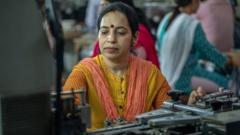The current landscape reveals that women contribute a mere 17% to India's GDP, significantly lower than the global average. A recent study highlights how promoting female-led businesses can increase women's workforce participation and economic efficiency. By addressing barriers to entrepreneurship, India's economy could witness substantial growth and improved female representation in the workforce.
Empowering Female Entrepreneurs: A Path to Enhanced Workforce Participation in India

Empowering Female Entrepreneurs: A Path to Enhanced Workforce Participation in India
A new study underscores the pivotal role of female entrepreneurship in increasing women's presence in the Indian workforce, emphasizing economic growth and empowerment.
The World Bank's analysis highlights a stark reality: despite women comprising half of the global population, they own less than 20% of businesses worldwide. This disparity significantly impacts women's participation in the workforce, which is particularly evident in India, where female labor participation has stagnated for three decades. However, a glimmer of hope exists in female entrepreneurship. Women represent about 14% of entrepreneurs in India, particularly thriving within micro, small, and medium enterprises (MSMEs).
These businesses, while they often operate on a smaller scale compared to their male counterparts, play a significant role in the economy. The 2023 State of India's Livelihoods Report indicates that female entrepreneurs are making notable contributions, yet their output accounts for only 17% of the country's GDP, ranking India 57th out of 65 countries regarding women's entrepreneurship.
Research conducted by Gaurav Chiplunkar of the University of Virginia and Pinelopi Goldberg of Yale University sheds light on how fostering female entrepreneurship can directly enhance women's workforce participation. Their research framework identifies barriers that restrict women's employment and entrepreneurship in India. The findings suggest that alleviating these hurdles could lead to an increase in female-led businesses, ultimately driving employment opportunities for women and enhancing economic growth through higher wages and more productive firms.
Key obstacles such as limited access to childcare, transportation, and entrenched social norms continue to create significant barriers for women. The notion that household responsibilities primarily fall on women hinders their ability to engage fully in the labor market. A study led by Rolly Kapoor from the University of California supports this, indicating that women's limited travel capabilities further restrict their labor participation.
Recent trends show a rise in self-employment among women; however, this often translates to disguised unemployment rather than productive employment. According to Ashwini Deshpande from Ashoka University, there is an urgent need for more women to transition into salaried positions with job security to facilitate economic empowerment.
With the current job market unable to meet growing workforce demands, research from Barclays indicates that India could achieve an 8% increase in GDP by ensuring that women constitute over half of the new workforce by 2030. Empowering female entrepreneurs may thus be a vital strategy not only for women's economic empowerment but also for the overall growth of India's economy.
As the country grapples with systemic barriers and an evolving workforce landscape, investing in female entrepreneurship presents a promising path forward in fostering inclusivity and economic resilience in India.





















